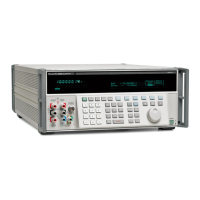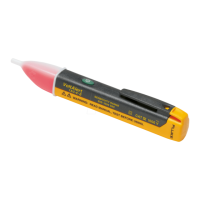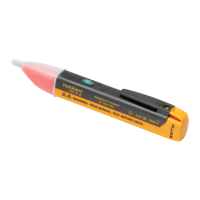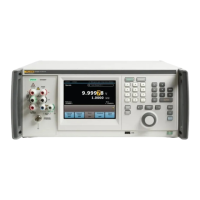Remote Operation
Commands 5
5-11
5-16. Multiple Commands
Controllers using BASIC may send commands all at once, or one at a time, in BASIC
PRINT statements. For example, if the calibrator’s bus address is 3 and you want to set
the calibrator to output 100 mV dc, some typical BASIC program statements would be:
1Ø REMOTE @3 ! PUT THE CALIBRATOR INTO THE REMOTE STATE
2Ø PRINT @3,”OUT 1ØØ MV” ! SELECT Ø.1V DC
3Ø PRINT @3,”OPER” ! ACTIVATE THE OUTPUT LIKE THE OPR/STBY KEY
You can achieve the same results by combining the two commands in one statement as
follows:
1Ø REMOTE @3
2Ø PRINT @3,”OUT 1ØØ MV ; OPER”
In both versions of the program, the PRINT statements transmit all necessary interface
messages (ATN and MLA) automatically.
5-17. Coupled Commands
When a compound command follows another command, there is a possibility that a fault
can occur because of the action of the first command. Such commands are called coupled
commands. An example of coupled commands that cause a fault is:
“OUT 1V, 1 MHZ”
followed by the compound command:
“OUT 100V” ; OUT 100 HZ.”
The second command causes a fault because when the calibrator encounters “OUT
100V”, it is interpreted as 100V, 1 MHz, which is out of range of the instrument. If only
the second compound command was sent, there would have been no fault and the
calibrator would be set to 100V at 100 Hz.
Another example is:
“OUT 1V ; RANGELCK ON”
followed by:
“OUT 10V ; RANGELCK OFF.”
In this case, when the calibrator interprets the first half of the second command, it causes
an error since the previous command locked the range on 2.2V.
Any command that affects the state of the output is a coupled command, i.e. order-
dependent. These commands include all the following: *RST, BOOST, BTYPE,
CAL_CHK, CAL_REF, CAL_STORE, CAL_ZERO, CUR_POST, DIAG, EXTGUARD,
EXTSENSE, FORMAT, INCR, LIMIT, MULT, NEWREF, OFFSET, OPER, OUT,
PHASE, PHASELCK, PHASESFT, RANGELCK, RCOMP, REMOTE, LOCAL,
LOCKOUT, SCALE, STBY, WBAND, CAL_RNG. Be careful to use appropriate
sequences when using these commands.

